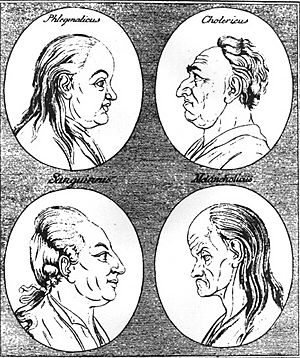Johann Kaspar Lavater facts for kids
Johann Kaspar Lavater was a famous Swiss poet, writer, and thinker. He was also a physiognomist, someone who studies faces to understand character, and a theologian, a religious scholar. He lived from 1741 to 1801.
Contents
Growing Up in Zürich
Johann Kaspar Lavater was born in Zürich, Switzerland. He went to school there, called a Gymnasium. Some of his teachers were J. J. Bodmer and J. J. Breitinger.
Fighting for What's Right
When Lavater was just 21 years old, he did something very brave. He and his friend, the painter Henry Fuseli, spoke out against a dishonest judge. This judge was forced to return the money he had taken unfairly.
A Life of Faith
In 1769, Lavater became a pastor in Zürich's Zwinglian Church. He worked in churches in his hometown until he died. People listened to him because he spoke with great passion and truly believed what he said. He had a lot of influence on others. Many people asked him for advice, and he was welcomed with excitement during his travels in Germany. His writings about spiritual ideas were also very popular.
Reading Faces: Physiognomy
Lavater is most famous for his work on physiognomy. This is the idea that you can learn about a person's character by looking at their face. His most well-known book on this topic was Physiognomische Fragmente zur Beförderung der Menschenkenntnis und Menschenliebe. It was published between 1775 and 1778.
Lavater believed that physiognomy could show specific traits of individuals. He didn't just look at general types of people. He also helped make silhouettes very popular. He thought that looking at the outline of a person's face could reveal their character. These outlines were often filled with black or cut from white paper and placed over a black background. Sometimes, they were simply cut from black paper. Lavater wrote that a silhouette, even though it's just a shadow, can "speak" a lot about a person.
His book became famous in France, England, and Germany. Its popularity was also due to its beautiful style and many illustrations. Lavater's ideas about physiognomy were influenced by earlier thinkers like Giambattista della Porta and Sir Thomas Browne.
A Gifted Poet
Besides his work on faces, Lavater was also a poet. He published a collection of Christian songs called Christliche Lieder. He also wrote two long poems, Jesus Messias and Joseph von Arimathia. He also wrote other books that explored inner thoughts and feelings, like Aussichten in die Ewigkeit (Views into Eternity) and Geheimes Tagebuch von einem Beobachter seiner selbst (Secret Diary of a Self-Observer).
Friends with Goethe
From 1774, Lavater became close friends with the famous German writer Johann Wolfgang von Goethe. However, they later had a disagreement. Goethe accused Lavater of being superstitious and dishonest.
Influence on William Blake
In 1788, the English poet and artist William Blake wrote notes on Lavater's book Aphorisms of Man. Lavater published 632 short, wise sayings called aphorisms. Blake thought one aphorism was especially good: "40. Who, under pressing temptations to lie, adheres to truth, nor to the profane betrays aught of a sacred trust, is near the summit of wisdom and virtue." This means that someone who tells the truth even when it's hard, and keeps secrets, is very wise and good.
Later Years and Death
In his later years, Lavater's influence became less strong. Some people even made fun of him because he seemed a bit vain. His actions during the French occupation of Switzerland led to his death. In 1799, when the French army took Zürich, Lavater tried to calm the soldiers. Sadly, he was shot by an angry soldier and died more than a year later, in 1801.
The Swiss artist and illustrator, Warja Honegger-Lavater, was a direct descendant of Johann Kaspar Lavater.
See also
 In Spanish: Johann Caspar Lavater para niños
In Spanish: Johann Caspar Lavater para niños




